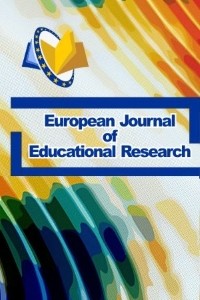Research Article
Year 2014,
Volume: 3 Issue: 4, 185 - 191, 15.10.2014
Abstract
References
- Creswell, J. W. (1994). Research designs: Qualitative and quantitative approaches. Thousand Oaks, CA: Sage.
- Creswell, J. W. (2003). Research design: Qualitative, quantitative, and mixed methods approaches (2nd ed.). Thousand Oaks, CA: Sage Publications.
- Donato, R. (1994). Collective scaffolding in second language learning. In J. P. Lantolf, & G. Appel (Eds), Vygotskian Approaches to Second Language Research (pp. 33-56). NJ: Ablex.
- Flor, A. M. (2010). Does language learners benefit from classroom interaction?
- Lantolf, J. P. (2000). Sociocultural theory and second language learning / edited by James P. Lantolf. Oxford [Eng.]. New York : Oxford University Press, 2000.
- Jina, L. (2008). Gesture and private speech in second language acquisition. Studies in Second Language Acquisition, 30(2), 169-190.
- Sato, M., & Lyster, R. (2012). Peer Interaction and Corrective Feedback for Accuracy and Fluency Development: Monitoring, Practice, and Proceduralization. Studies in Second Language Acquisition, 34(4), 591-626.
- Swain, M. (1995). Three functions of output in second language learning. In G. Cook and
- B. Seidhofer (eds.) Principles and practise in applied linguistics. Oxford, Oxford University Press.
- Philp, J., Walter, S. & Basturkmen, H. (2010). Peer Interaction in the Foreign Language Classroom: What Factors Foster a Focus on Form?. Language Awareness, 19(4), 261-279.
- Ohta, A. (1995). Applying Sociocultural Theory to an Analysis of Learner Discourse: Learner-Learner Collaborative Interaction in the Zone of Proximal Development. Issues In Applied Linguistics, 6(2), 93.
- Oxford, R. & Shearin, J. (1994). Language learning motivation: Expanding the theoretical framework. Modern Language Journal, 78, 12-28.
- Wertsch, J.V. (1985). Vygotsky and the social formation of mind. Cambridge, MA: Harvard University Press.
- Vygotsky, L. S. (1981). The development of higher forms of attention in childhood. In J. V.Wertsch, ed. The concept of activity in Soviet psychology. Armonk, NY: M.E. Sharpe, 189-239.
- Vygotsky, L. S. (1962). Thought and language. Cambridge, MA: MIT Press.
Socio-cultural Factors in Second Language Learning: A Case Study of Adventurous Adult Language Learners
Abstract
Sociocultural theories consider language learning as a social practice examines students as active participants in the construction of learning processes. This study investigates sociocultural theories’ central concepts, which includes peer interaction and feed back, private speech, and self-efficacy. The present study is a case study of twenty participants. The participants for this case study were from different nationalities that demonstrated a unique ability to learn languages long after the critical period. Data was collected through interviews and observations. The participant mentioned about the process and the challenges/opportunities he experienced regarding second language learning. By analyzing the learning practices of other successful adult language learners, recurring patterns revealed similarities, which were then emphasized and elaborated in second language pedagogy.
References
- Creswell, J. W. (1994). Research designs: Qualitative and quantitative approaches. Thousand Oaks, CA: Sage.
- Creswell, J. W. (2003). Research design: Qualitative, quantitative, and mixed methods approaches (2nd ed.). Thousand Oaks, CA: Sage Publications.
- Donato, R. (1994). Collective scaffolding in second language learning. In J. P. Lantolf, & G. Appel (Eds), Vygotskian Approaches to Second Language Research (pp. 33-56). NJ: Ablex.
- Flor, A. M. (2010). Does language learners benefit from classroom interaction?
- Lantolf, J. P. (2000). Sociocultural theory and second language learning / edited by James P. Lantolf. Oxford [Eng.]. New York : Oxford University Press, 2000.
- Jina, L. (2008). Gesture and private speech in second language acquisition. Studies in Second Language Acquisition, 30(2), 169-190.
- Sato, M., & Lyster, R. (2012). Peer Interaction and Corrective Feedback for Accuracy and Fluency Development: Monitoring, Practice, and Proceduralization. Studies in Second Language Acquisition, 34(4), 591-626.
- Swain, M. (1995). Three functions of output in second language learning. In G. Cook and
- B. Seidhofer (eds.) Principles and practise in applied linguistics. Oxford, Oxford University Press.
- Philp, J., Walter, S. & Basturkmen, H. (2010). Peer Interaction in the Foreign Language Classroom: What Factors Foster a Focus on Form?. Language Awareness, 19(4), 261-279.
- Ohta, A. (1995). Applying Sociocultural Theory to an Analysis of Learner Discourse: Learner-Learner Collaborative Interaction in the Zone of Proximal Development. Issues In Applied Linguistics, 6(2), 93.
- Oxford, R. & Shearin, J. (1994). Language learning motivation: Expanding the theoretical framework. Modern Language Journal, 78, 12-28.
- Wertsch, J.V. (1985). Vygotsky and the social formation of mind. Cambridge, MA: Harvard University Press.
- Vygotsky, L. S. (1981). The development of higher forms of attention in childhood. In J. V.Wertsch, ed. The concept of activity in Soviet psychology. Armonk, NY: M.E. Sharpe, 189-239.
- Vygotsky, L. S. (1962). Thought and language. Cambridge, MA: MIT Press.
There are 15 citations in total.
Details
| Primary Language | English |
|---|---|
| Subjects | Studies on Education |
| Other ID | JA67AM52KN |
| Journal Section | Research Article |
| Authors | |
| Publication Date | October 15, 2014 |
| Published in Issue | Year 2014 Volume: 3 Issue: 4 |


